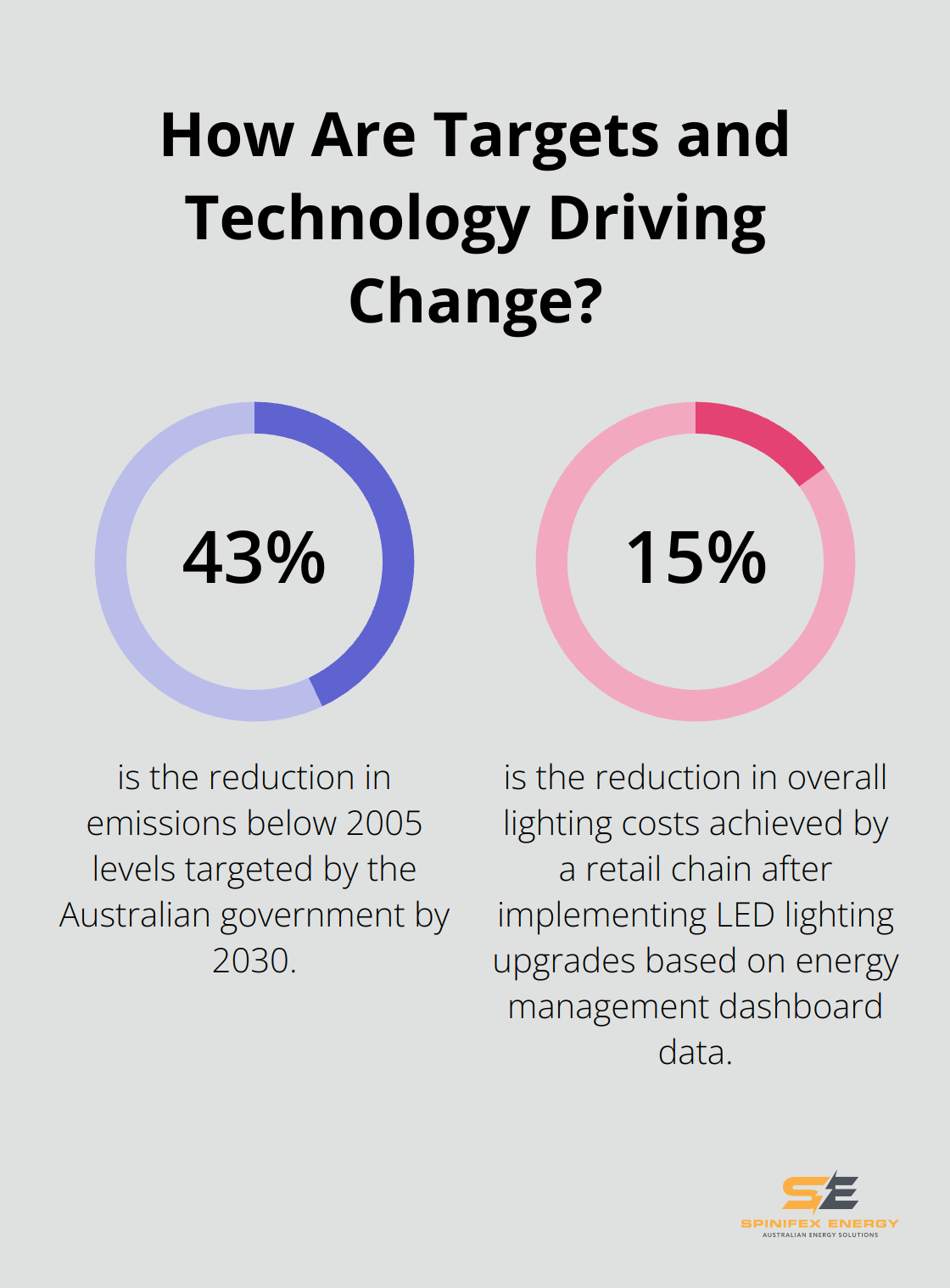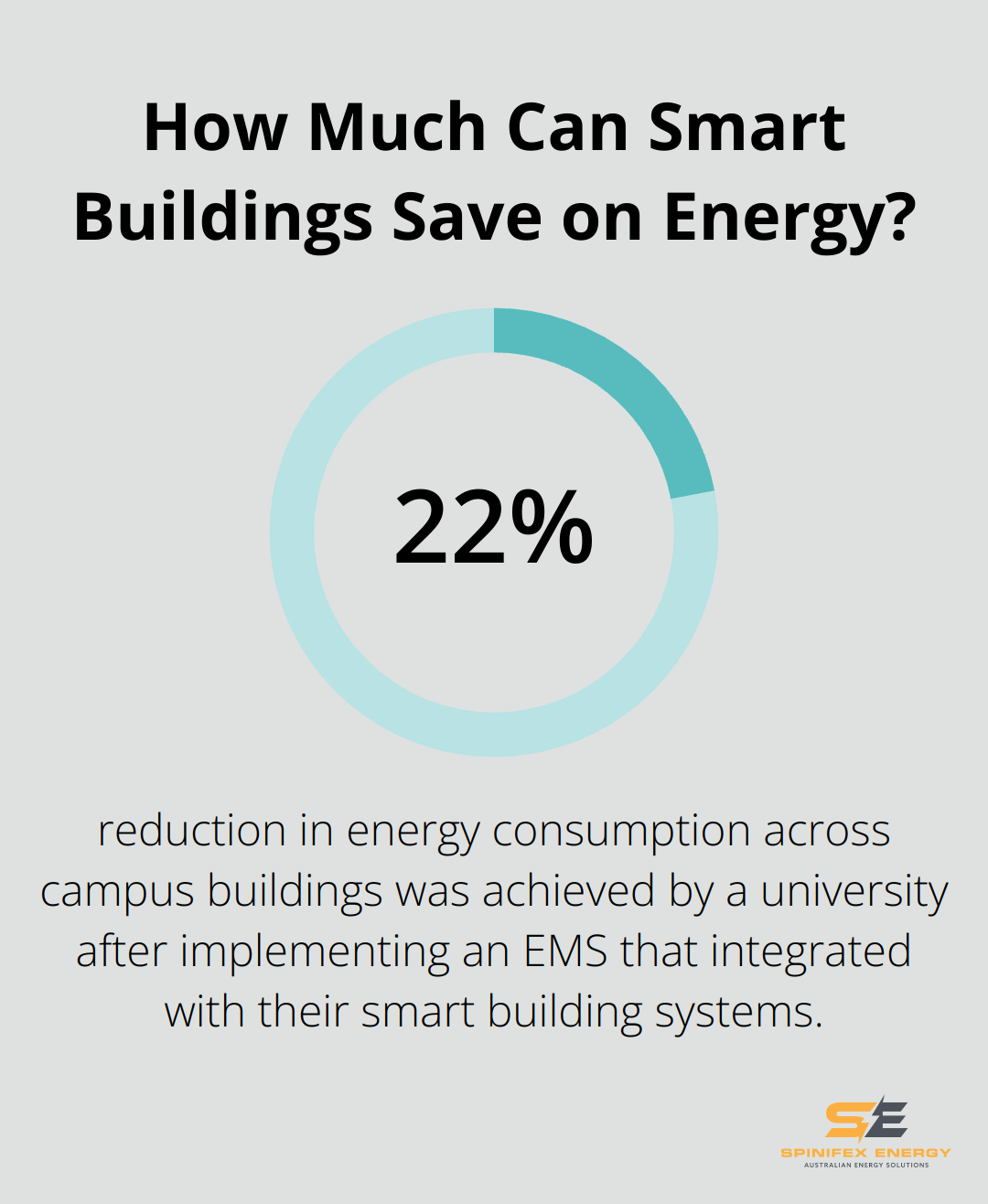Energy management systems software has become a game-changer for businesses looking to optimize their energy consumption and reduce costs. At Spinifex Energy, we’ve seen firsthand how these powerful tools can transform operations and drive sustainability efforts.
With the right software, companies can gain unprecedented insights into their energy usage patterns and make data-driven decisions to improve efficiency. In this post, we’ll explore the key features, benefits, and factors to consider when choosing an energy management system that fits your organization’s needs.
What Makes Energy Management Systems Powerful?
Real-Time Monitoring: The Foundation of Energy Control
Energy management systems (EMS) software provides businesses with unprecedented control over their energy consumption. At its core, EMS offers real-time insights into energy consumption. This continuous data stream enables companies to identify inefficiencies quickly and implement immediate adjustments.
Advanced Analytics: Turning Data into Action
The true power of EMS software lies in its ability to analyze vast amounts of energy consumption data. These systems identify patterns, predict future usage, and suggest optimization strategies. For example, a manufacturing plant using EMS software might discover that certain machines consume significantly more power during specific production cycles (allowing managers to adjust schedules for optimal energy use).
Proactive Management: Automated Alerts for Instant Response
EMS software doesn’t just collect data; it actively helps manage energy use. Automated alerts notify facility managers when consumption spikes occur or when equipment operates outside optimal parameters. This proactive approach prevents energy waste and reduces the risk of equipment failure. If a building’s HVAC system suddenly starts consuming more energy than usual, an alert prompts immediate investigation and maintenance (potentially saving thousands in energy costs and preventing a breakdown).
Seamless Integration: Unifying Building Systems
Modern EMS solutions integrate with existing building management systems, creating a unified platform for controlling all aspects of a facility’s operations. This integration allows for more sophisticated energy-saving strategies, such as automatically adjusting lighting and temperature based on occupancy or time of day. Some clients have reduced their energy consumption by up to 30% through such integrated approaches.
Customizable Dashboards: Tailored Insights for Every User
EMS software offers customizable dashboards that present data in clear, actionable formats. These user-friendly interfaces allow different stakeholders-from facility managers to C-suite executives-to access the information most relevant to their roles. This feature ensures that everyone in the organization can contribute to energy-saving initiatives effectively.

The combination of these powerful features transforms a company’s approach to energy management. As businesses look to implement EMS solutions, they must consider how these features align with their specific needs and goals. The next section will explore the tangible benefits that result from implementing a well-chosen energy management system.
Why Implement Energy Management Systems?
Slash Energy Costs
Energy Management System (EMS) software offers substantial cost reductions for businesses. Case studies document the energy savings achieved by large manufacturing companies using AMO’s software tools, other technical publications, and best practices.

A manufacturing plant in Melbourne reduced energy consumption by 25% after implementing an EMS, resulting in annual savings of AUD 500,000. These savings come from the identification and elimination of energy waste, optimization of equipment performance, and shifting of energy-intensive processes to off-peak hours when electricity rates are lower.
Shrink Carbon Footprints
EMS plays a vital role in reducing an organization’s environmental impact. These systems provide detailed insights into energy consumption patterns, which enable businesses to identify and address inefficiencies that contribute to unnecessary carbon emissions.
A study found that energy management practices are still very much in their infancy, and concern for carbon emissions is limited in the Malaysian manufacturing industry.
Gain Operational Control
EMS software provides unprecedented visibility into energy usage across an entire organization. This granular view allows facility managers to identify specific areas or equipment that consume excessive energy, enabling targeted interventions.
A hotel chain using EMS discovered that their laundry facilities were major energy consumers. The optimization of laundry schedules and upgrade to energy-efficient machines reduced energy consumption in this area by 40%. This level of control extends to all aspects of operations, from lighting and HVAC to production equipment.
Ensure Regulatory Compliance
As energy regulations become increasingly stringent, EMS helps businesses stay compliant and avoid costly penalties. In Australia, where the government aims to reduce emissions by 43% below 2005 levels by 2030, EMS becomes an essential tool for businesses to track and report their energy usage accurately.
EMS software automates the collection and reporting of energy data, making it easier to comply with standards like ISO 50001 and local energy efficiency regulations. This not only saves time and resources but also reduces the risk of non-compliance fines.
Drive Smart Energy Investments
One of the most valuable long-term benefits of EMS is its ability to inform strategic decision-making around energy investments. EMS provides detailed data on energy consumption patterns and costs, which helps businesses identify the most impactful areas for improvement.
A retail chain used energy management dashboards to prioritize LED lighting upgrades across its stores, focusing first on locations with the highest energy costs. This data-driven approach resulted in a 15% reduction in overall lighting costs and a payback period of just 18 months for the upgrades.
The implementation of an Energy Management System offers more than just cost-cutting benefits; it provides a competitive edge through improved efficiency, sustainability, and strategic energy use. As we move forward, it’s essential to consider the key factors in selecting the right EMS software for your organization’s specific needs and goals.
How to Choose the Right Energy Management System
Selecting the ideal Energy Management System (EMS) for your organization will significantly impact your energy efficiency and cost-saving efforts. We identified key factors that can make or break your EMS implementation.
Future-Proof Your Energy Management
When you evaluate EMS options, consider the scalability of the solution. Your energy needs will likely evolve as your business grows, so choose a system that adapts to these changes. Look for modular designs that allow you to add new features or expand monitoring capabilities without overhauling the entire system.

A mid-sized manufacturing company initially needed basic energy monitoring. As they expanded, they required more advanced analytics and multi-site management. Their scalable EMS easily accommodated these growing needs.
Prioritize User Experience
The most powerful EMS becomes useless if your team can’t effectively use it. Try systems with intuitive interfaces and clear data visualization. During the selection process, involve the end-users – from facility managers to C-suite executives – to ensure the system meets their specific needs.
Case studies from various industries, such as manufacturing, logistics, and data centers, demonstrate the tangible benefits of implementing user-friendly EMS solutions.
Ensure Seamless Integration
Your EMS shouldn’t operate in isolation. It needs to work harmoniously with your existing infrastructure. Before you commit to a system, conduct a thorough audit of your current hardware and software. Ensure the EMS integrates with your building management systems, IoT devices, and other relevant platforms.
A university chose an EMS that seamlessly integrated with their existing smart building systems. This integration allowed for automated adjustments to HVAC and lighting based on occupancy data, resulting in a 22% reduction in energy consumption across campus buildings.
Evaluate Vendor Support and Reputation
The relationship with your EMS provider doesn’t end at purchase. Ongoing support maintains and optimizes your system. Research potential vendors thoroughly. Look for providers with a track record of reliable customer support and regular software updates.
Check case studies and client testimonials. While Schneider Electric, a major player in the EMS market, is known for its comprehensive support services, energy management systems companies offer personalized support that ensures your EMS continues to deliver value long after implementation.
Calculate ROI and Total Cost of Ownership
While upfront costs matter, they shouldn’t be your only financial consideration. Calculate the total cost of ownership over the system’s lifetime, including installation, training, maintenance, and potential upgrades.
More importantly, estimate the return on investment. A good EMS should pay for itself through energy savings. An industrial client saw a full ROI on their EMS investment within 14 months, with ongoing annual savings of over $300,000.
Final Thoughts
Selecting the right energy management systems software will significantly impact your organization’s efficiency, sustainability, and bottom line. These powerful tools offer real-time monitoring, advanced analytics, and seamless integration with existing systems, providing unprecedented control over energy consumption. The benefits of implementing an effective EMS extend far beyond immediate cost savings, positioning businesses for long-term success in an increasingly energy-conscious world.

When you evaluate EMS options, consider factors such as scalability, user-friendliness, integration capabilities, vendor support, and overall return on investment. A well-chosen system should adapt to your growing needs, work seamlessly with your existing infrastructure, and ultimately pay for itself through energy savings. Your team should find the system easy to use (this is essential for widespread adoption and maximum benefit).
At Spinifex Energy, we specialize in providing tailored energy consulting services, helping businesses optimize their energy procurement and implement advanced solutions. Our team of experts can ensure that your EMS implementation aligns perfectly with your organization’s unique needs and goals, maximizing both savings and sustainability. Investing in robust energy management systems software today will help you take control of your energy consumption and contribute to a more sustainable future.

